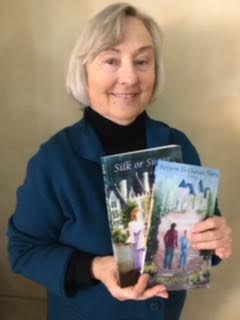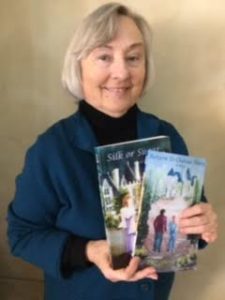
Plots Interview with Historical Fiction Author Elizabeth Pye
Plots – Elizabeth Pye,
Explains Plots for her French Connection Series

How do authors determine plots? Elizabeth Pye, historical fiction author of Silk or Sugar, explains how she determines plots for her French Connection series. Historical fiction comes alive when the author has creatively intertwined historical events and famous figures with a fascinating plot. Author Elizabeth Pye accomplishes this by bringing the French Revolution to life in the story of Janine de Fleury and Etienne Tremeau.
Determining the plot of the story involves these four elements:
- Conflict
- Suspense
- Climax
- Resolution
How an author accomplishes these storyline elements varies. Elizabeth gives us pointers on how she weaves historical events and characters together to draw her readers’ interest.
Does Building a Storyline’s Plot Require an Outline?
Authors differ on whether or not to use an outline to effectively build a book’s plot. Find out Elizabeth’s plotting techniques as she explains her writing process in the interview selection below.
Angie: How do you work on plots for your books?
Elizabeth: Let me preface that by saying, I know how you should work on a plot, but I don’t know whether the word “should” is exactly right. I think you work on the plot however you work on it most efficiently. So there are the story arcs that are very important that you get them in – the plot and points and so on, and I certainly do that. But I don’t outline line the whole thing from beginning to end.
Outline or not?
A confession is that I don’t even know the end, other than the romance – since I write romance – that the couple is going to get together. I first think about it, think about my characters, the setting and what the conflict is. All of these things, elements of what you need to know and what they are. That’s all going on in my mind, nothing on paper. When it comes together for me, I make a rough outline – very rough, brief outline. And then I start writing my beginning chapters and research each chapter that is being written.
I want to get all the details right. I don’t want to make any errors such as having a car back in the 1500s, for example. It takes a lot of time to look up all these details and make sure you’re representing them as accurately as you can. So after I’ve done all that research, I write the chapter. I probably have about four chapters ahead in my mind, and then I have that rough outline that I’ve done. Maybe it will take a different direction than what the outline has thought. I follow that direction it’s taking and revise my outline.
I find, though, that – particularly at mid-point in the book, I’ll hit another one of those arcs – things really come together. It’s like a puzzle. I know the rest of the story. Again, it’s doing my research, following up on it, and waiting for inspiration on each chapter. And that’s where the muse comes in.
Keeping Notes
I’ll often wake up in the middle of the night, and I’ve got a whole two or three scenes for a chapter that just come to me and it wasn’t quite that way before. I have to get up and turn on the light and write that down or it will be gone. It goes that quickly.
Angie: So you keep a journal or notebook?
Elizabeth: By the bed. Yes, and I have to do that.
Angie: Do you also keep them other places in the house or in your car?
Elizabeth: Oh, yes. I don’t have it in the car.
Angie: You wouldn’t write in the car but you’d take one with you.
Elizabeth: Generally not because my inspirations and ideas come at home mostly. There has to be somewhat of a relaxation mind, I think, of the conscious mind. Then the thoughts and the subconscious can rise to the surface. Then you’re aware of what it is. That’s why I don’t think when I’m out shopping or listening to a program somewhere that…but it doesn’t mean that it couldn’t happen. It could. And then I have a small notebook in my purse, but normally it doesn’t happen too often but occasionally. At home I have them all around the house – the notebooks because they hit anywhere (the thoughts, ideas). Because your mind is still, and it comes in the stillness of the mind.
Angie: Very interesting. Thank you.
Visit my Facebook author page to stay up to date on The French Connection series.
– Elizabeth Pye